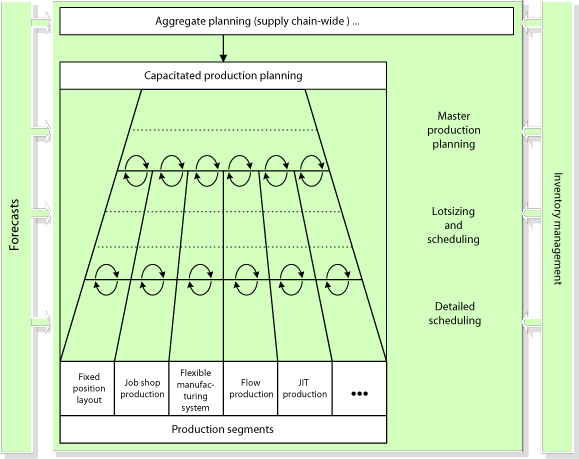Deterministic Planning Problems
Most modules of Advanced Planning Systems consider a deterministic planning situation. In this case, all relevant planning data are known with certainty. A hierarchical structure for operative production planning and control comprises the following planning steps:
- Aggregate production planning
- Master planning
- Lotsizing and scheduling
- Detailed scheduling
According to the mainstream of production and operations management textbooks, the aggregate planning level focuses on the general course of action to find a production plan which reflects the dynamics of the aggregate demand forecasts as well as the costs associated with the building up of inventory and the use of overtime and/or variable workforce levels. The planning horizon is often one year or more. The resulting plan shows the development of the production and purchasing quantities as well as the usage of the resources over time. The planner is taking a longer perspective and minimizes the negative effects of short-term variations. The variables and constraints are defined in aggregate units. As the decision maker has an aggregate view of the problem, he is allocated to a higher level in the production planning hierarchy. In companies running multiple factories located in different parts of the world, the aggregate planning task covers the coordination of the production quantities among these factories, including planning of transportation. Located immediately below the aggregate level, on the master production planning level, the specific timing and sizing of production quantities of main products or finished products are defined, thereby possibly taking the multi-level structure of the production processes into account.
The resulting master production schedule defines the external demands that must be met through production activities for sub-assemblies and components. In the standard MRP approach this planning level is called "Master Production Scheduling” which has up to now mainly been treated without a formal decision model.
The next planning level considers the specific problems which arise in the different production layouts, such as job shop production or flow production. Here, different types of lotsizing problems arise in combination with different layout-specific scheduling and sequencing problems. The following figure emphasizes the segmented structure of this layer of production planning. The depicted segmentation of problem types and resulting decision models, in addition to the explicit consideration of the limited capacities of the resources, is a significant characteristic which distinguishes the capacity-oriented production planning from the standard MRP approach.

See also: